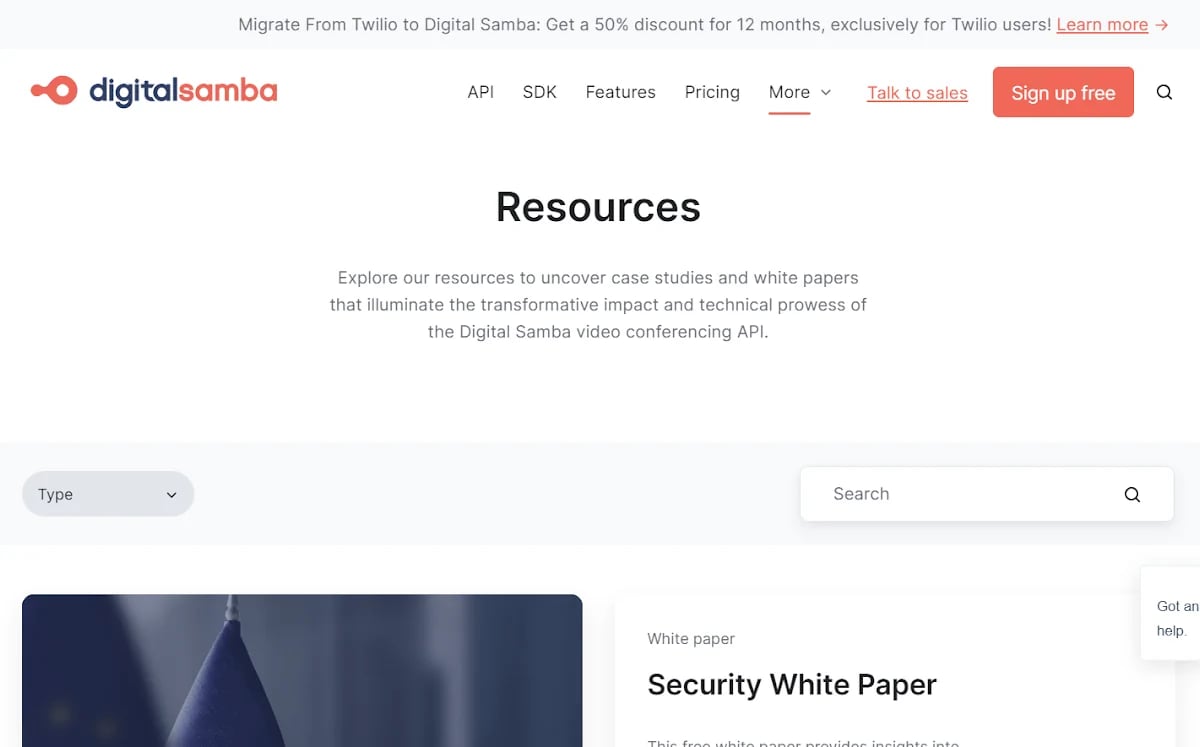Mastering REST API Documentation for Video Conferencing Success
Imagine levelling up your app with seamless video conferencing, making it feel like a breeze for your users. But hold up — we developers need a solid roadmap to navigate this awesome terrain. That's where well-documented REST APIs swoop in, playing the role of your reliable wingman and unlocking all the goodies these features have to offer.
Here's the deal: having super detailed instructions is like having the treasure map to unlock the full potential of your REST API. Armed with this knowledge, developers can effortlessly tap into these features, leading to more peeps hopping on board and building a lively community around your app.
This ultimate guide is your backstage pass to the best practices for crafting crystal-clear documentation tailored specifically for REST API integrations. Get ready to transform your REST API reference from a snooze-worthy manual into an exciting roadmap to success.
Table of contents
- What is the API documentation?
- Types of API documentation
- Who writes API documentation?
- What are the benefits of documenting APIs?
- How to create good REST API documentation
- The structure of API documentation
- The best practices for documenting APIs
- Wrapping up
What is the API documentation?
So, in the tech world, APIs are like the magic glue that lets different apps chat it up. And you know what keeps everyone on the same page? API documentation – it's the ultimate guidebook. Inside, you'll find all sorts of cool stuff like code examples, tutorials, and the nitty-gritty of how the API works and what it can do.
So, what's the deal with API docs? Well, for developers, it's like having a cheat sheet for weaving API magic into their own creations. And for partners, it's their lifeline for smoothly integrating your API into their products or services, making sure everything meshes well. Plus, there are user-friendly guides for end-users to make using your API a breeze.
Nailing down top-notch API documentation isn't just about creating a snooze-worthy manual – it's about crafting a roadmap to success. That means smoother sailing for developers, easier product upkeep, and a faster track to squashing any pesky bugs that pop up.
Types of API documentation
For team
Internal APIs are like the secret sauce that's exclusively for your team's use within your organisation. They're all about making sure data flows smoothly between different teams and systems in-house. Usually, it's your organisation's own developers who handle these APIs, using them to streamline how everything works internally and keep the communication channels wide open.
For partners
Think of API documentation as the trusty bridge that helps partners seamlessly integrate REST APIs. It's like their go-to toolkit, packed with everything they need: step-by-step instructions, breakdowns of data formats, tips on authentication methods, real-life code examples, and practical use cases.
Take, for instance, the Digital Samba video conferencing API documentation. It's a shining example of clarity and comprehensiveness, covering everything from setting up an account to making the most of our features.
For end-users
Many REST APIs are like open houses, inviting developers to come in and make the most of their features. These Open APIs are all about accessibility, but that doesn't mean they skimp on top-notch documentation. Nope, here, it's all about user-friendly guides, easy-to-follow tutorials, and plenty of support materials to get everyone on board.
Now, here's the scoop: Sometimes, these goodies might come with a price tag, depending on how many times you're ringing the API's doorbell. But hey, it's all about making sure you've got what you need to dive in and start building.

10 Mistakes Developers Make While Developing Video Conferencing Applications
Read the blog
Who writes API documentation?
Here's the breakdown:
Crafting API documentation is usually a team effort. You've got your technical writers, who are like the storytellers of the tech world. They make sure the documentation speaks to everyone, whether you're a seasoned developer or just dipping your toes in.
Then there are the developers – they're the masterminds behind the scenes, giving you all the juicy details on how the API works in the real world. Their hands-on experience keeps the documentation on point, ensuring it's accurate and helpful.
Last but not least, you've got the product managers. They're the ones who champion the users, making sure the documentation lines up with the big picture of the product and meets the needs of both insiders and outsiders. Their mission? To make sure everyone can tackle the REST API like a boss.What are the benefits of documenting APIs?
Enhances the API’s developer experience
Picture this: Even the most mind-blowing API won't do much if developers can't wrap their heads around it, right? That's where API documentation swoops in – it's like your ninja tool for turning developers into coding superheroes.
With crystal-clear documentation in hand, developers get the ultimate roadmap. It walks them through all the nitty-gritty details – from what each function does to how to tweak those endpoints and parameters. And the best part? It's all laid out in plain English, so there's no need for a decoder ring. This smooths out the learning curve, meaning they can start flexing the muscles of your API in a flash.
Streamlines onboarding and empowers your team
API documentation isn't just a beginner's tool – it's the powerhouse knowledge hub that empowers your entire team. From seasoned developers to product managers and support champs, everyone's in the loop.
When it's time to tweak the API or unveil shiny new features, having everyone on board means smooth sailing. This turbocharges your product maintenance game and lets you zip through updates like a boss.
Benefits users beyond your internal walls
API documentation isn't just an internal affair – it's your ticket to reaching users far and wide. Picture this: even folks who aren't coding wizards can become fluent in your REST API language, thanks to clear-as-day documentation.
It's like having a universal translator that opens the doors to epic video conferencing experiences for everyone. So, when you nail down that crystal-clear documentation, you're not just helping your team – you're setting the stage for a whole new level of connection.
A universe of resources, not just a manual
API documentation isn't just a set of instructions – it's like a time capsule that holds the story and vision behind the design. And this isn't just gold for your seasoned pros; it's a treasure map for new recruits, too.
With this insight, fresh faces can quickly get up to speed, understanding the logic behind the API's journey and jumping right into shaping its future. This ensures your REST API stays at the top of its game as your video conferencing platform evolves.
And hey, let's not forget: API documentation can go beyond the basics. Many organisations, like Digital Samba, go the extra mile with blogs or resource sections that dive deep into topics within their niche. It's like having a whole library of wisdom at your fingertips!

Allows developers to identify bugs and product issues quickly
Well-documented APIs are like having a superhero sidekick for debugging. They come packed with all the tools needed to tackle any issues that pop up along the way.
Think about it: with clear explanations on error handling, status codes, and troubleshooting tips, developers can zoom in on problems faster than you can say "bug." And the result? Less downtime and a rock-solid API that everyone can rely on.
How to create good REST API documentation
REST (Representational State Transfer) is the go-to architectural style for APIs, and video conferencing is right there in the mix. Now that we've talked up the perks of top-notch documentation let's dive into the must-know steps for creating the best practices for REST API documentation, specially tailored for video conferencing integrations:
Clarity is key
Keep it crystal clear and straight to the point. Your audience includes devs at all skill levels, so make sure your language breaks down even the trickiest bits into easy-to-digest nuggets. Ditch the jargon and keep things well-structured so users can pick up what you're putting down without breaking a sweat.
Organisation is everything
Consistency rules
The devil's in the details

How to Integrate Video Conferencing into Your Website
Read the blog
The structure of API documentation
An outline
The outline in your API documentation serves as a navigational tool, directing users to the exact information they require. It presents the API's functionalities, such as endpoints and parameters, in a well-organized manner. Imagine it as a quick reference guide for developers, partners, and anyone seeking swift access to pertinent details. Here's an exemplary outline offering a glimpse into the Digital Samba documentation page:

Tutorials
Tutorials are the heart and soul of API documentation, providing users with straightforward, step-by-step instructions for utilising the API to accomplish specific tasks. Tutorials demystify the implementation process by walking users through practical examples, illuminating usage scenarios, and highlighting best practices. These tutorials not only demonstrate the API's capabilities but also empower users to integrate it into their applications seamlessly.
Authentication
Security plays a pivotal role in video conferencing platforms. In the authentication section, developers find the lowdown on securely accessing your API within your documentation. Here's what it usually covers:
- Obtaining API keys: This section explains how developers can obtain the credentials needed to engage with the API. Clear instructions ensure that they're equipped to proceed.
- Implementing authentication mechanisms: Here, we explore the various authentication methods supported by the API (think OAuth) and provide a detailed roadmap for developers to integrate these mechanisms seamlessly into their workflows.
- Managing user authorisation: This aspect guides developers on how to wield the power of user access levels and permissions within the realm of video conferencing functionalities. It's all about ensuring the right folks have the right access at the right time.
Here is an example from the Digital Samba REST API Authentication documentation:

By providing clear authentication instructions, you ensure developers can securely integrate your video conferencing API, protecting user data and platform integrity.
Endpoint definition
Think of API endpoints as the doorways through which developers interact with your video conferencing platform. The endpoint definition section provides a comprehensive reference for each endpoint, detailing its purpose and functionalities. A well-structured endpoint definition should include:
- Endpoint URL: The specific URL path used to access the functionality.
- HTTP method: The HTTP method used for the request (e.g., GET, POST, PUT, DELETE).
- Request parameters: A detailed explanation of the expected parameters and their data types.
- Response structure: A breakdown of the data returned by the API in response to a request.
Here is an excellent request-response structure on the Digital Samba REST API documentation page:

By providing clear and concise endpoint definitions, you empower developers to understand how to interact with each functionality offered by your video conferencing API.
Status and error codes
Status and error codes are like the secret language of API documentation. They're the signals that tell developers when things aren't going according to plan. These codes don't just flag issues; they also provide valuable insights into what went wrong and how to fix it. In your API documentation, error codes serve as your trusty guides, offering instructions on troubleshooting errors, handling exceptions, and resolving any other hiccups developers might encounter. They're the roadmap to smoother sailing in the world of API interactions.
Examples
Once users grasp the inner workings of your API, examples step in to bring those functionalities to life. They're like the show-and-tell portion of your documentation, helping users visualise how the API behaves in real-world scenarios.
With examples, users get a firsthand look at how to structure requests and decode responses effectively. Take, for example, the code snippet on our site that showcases making API requests to fetch data. These snippets clearly show what goes into a request and what kind of response you can anticipate in return. It's like having a front-row seat to the API in action.
Glossary
Navigating through technical terms can sometimes feel like deciphering a foreign language. That's where a robust glossary steps in to save the day. Consider it your API dictionary, packed with crystal-clear definitions of all the essential terms, acronyms, and jargon sprinkled throughout the documentation. This glossary is particularly handy for newcomers or those just dipping their toes into the world of a specific API. It's like having a trusty guide by your side, helping you decode the language of APIs with ease.
The best practices for API
documentation
Crafting top-notch API documentation isn't just about giving out instructions; it's about building a communication bridge that empowers developers to wield the full power of your video conferencing platform. Here are some key best practices to consider:
- Know your audience: Developers come in all shapes and sizes. By clearly defining your target audience, you can customise the documentation's language, depth, and level of detail. For example, documentation for external developers integrating video conferencing features may differ from internal docs meant for your engineering team.
- Keep it clear: Jargon-heavy docs can be a real buzzkill. Aim for clarity, brevity, and plain English. Break down even the most complex functionalities into digestible bits for developers of all skill levels. Remember, the goal is to empower, not to baffle.
- Stay up-to-date: API documentation is a living, breathing creature that evolves alongside your platform. Make it easy for developers to find the latest version by including prominent links within your platform and developer portal. Consider versioning your docs to ensure everyone's working with the most current info.
- Show, don't just tell: Don't just throw instructions at developers; paint them a picture. Incorporate code snippets showcasing how to interact with specific API endpoints. And why stop there? Toss in some real-world use cases tailored to video conferencing functionalities. This helps developers visualise how to integrate your features into their apps and troubleshoot any snags along the way. Check out this example from Digital Samba on requesting the Digital Samba API.
- Assign ownership: Exceptional API documentation doesn't just materialise out of thin air. It's essential to designate responsibility to a dedicated individual, whether it's a technical writer or a developer with excellent communication skills. This person ensures that the documentation remains accurate and up-to-date and adheres to industry best practices.
- Integrate documentation into development: Don't treat API documentation as an afterthought. Instead, seamlessly weave it into your development process. Encourage developers to update the documentation as they create new features or squash bugs. This collaborative approach ensures harmony between the API and its documentation, resulting in a smoother development journey for everyone involved.
FAQs
The video conferencing documentation meaning refers to detailed guides, references, and resources provided to developers to help them integrate video conferencing APIs into their applications. Proper documentation ensures that developers can seamlessly use APIs to enable video functionalities, troubleshoot issues, and optimise performance.
API documentation best practices include writing crystal clear documentation, providing examples, using consistent formatting, and maintaining updated information. This helps developers understand how to integrate and use APIs effectively, reducing confusion and streamlining the integration process.
Extensive API documentation is essential for video conferencing integrations because it provides developers with detailed information on how to utilise the API effectively. It includes instructions, examples, and troubleshooting tips, making the integration process smoother and reducing development time.
A video API reference should include endpoint details, request and response formats, authentication methods, error codes, and usage examples. This information helps developers integrate video functionalities into their applications efficiently and reduces the chances of errors during implementation.
Common challenges in video API documentation include keeping the documentation up to date with new features, providing clear examples, and ensuring the documentation is accessible to both novice and experienced developers. Addressing these challenges helps improve the overall developer experience.
Good documentation directly impacts the success of video conferencing API integrations by reducing implementation errors, speeding up the development process, and enabling developers to leverage the full capabilities of the API. It ensures a more seamless integration experience, leading to higher satisfaction for both developers and end-users.
Wrapping up
Crafting clear and comprehensive API documentation is like handing developers, partners, and end-users the ultimate cheat code. It's their ticket to unlocking your platform's full potential. By serving up clear explanations, practical examples, and a sprinkle of storytelling, you can turn dull instructions into an exciting roadmap.
Investing in stellar documentation is like building a bridge straight to a bustling developer community. When developers feel supported, they're more likely to dive headfirst into your platform and dream up some seriously cool integrations. It's a win-win situation!
Ready to take your video conferencing game to the next level? Let Digital Samba lead the way. With seamless integrations and comprehensive documentation at your fingertips, your business is primed to soar. Get in touch with us today, and let's make it happen!
Share this
You May Also Like
These Related Stories

Resolving Common REST API Errors: Troubleshooting Common Issues

What Are The Different Types Of Video API?

